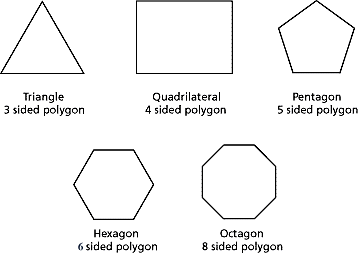Equilateral Triangle  |
Square
 |
Regular Pentagon
 |
Regular Hexagon  |
Regular Octagon  |
|
polygons
A regular triangle is called an Equilateral Triangle.
A regular quadrilateral is called a Square.
Below you will pictures of some common regular polygons.
Equilateral Triangle  |
Square
 |
Regular Pentagon
 |
Regular Hexagon  |
Regular Octagon  |
|
Identifying and Classifying PolygonsWhen people hear the word geometry, they tend to think about shapes. These shapes surround their lives each and every day. Many of these shapes, or polygons, can be described as flat closed figures with 3 or more sides. Polygons are two-dimensional objects, not solids. Polygons are classified and described by the number of sides, the kind of angles, and whether any of the sides are the same length (or congruent). Many polygons have special names. 
This figure shows the most common polygons. Notice that we identified a 4-sided polygon as a quadrilateral. More commonly, you'd call this shape a rectangle, but a rectangle is only one kind of quadrilateral. A rectangle is a special quadrilateral where opposite sides are congruent -- that is, the same length -- and each angle is a right angle. A square is also a special quadrilateral because all four sides are congruent and all four angles are right angles. Notice the similarities between rectangles and squares: They both are quadrilaterals (four sided polygons).The one important difference is that all four sides are congruent for a square. You could put it this way: All squares are rectangles, but not all rectangles are squares. Triangles have their own special cases as well. An equilateral triangle can be thought of as the square's cousin since all three sides are congruent. Another special triangle is the isosceles triangle, where only two sides are congruent. A scalene triangle has no congruent sides.
|
Identification quiz http://www.coe.tamu.edu/~strader/Mathematics/Geometry/PolygonLesson/identify.html
Poly-based words http://www.coe.tamu.edu/~strader/Mathematics/Geometry/PolygonLesson/polyname.html
Figures and Polygons (a good website to look at before the lesson for visual examples and definitions)